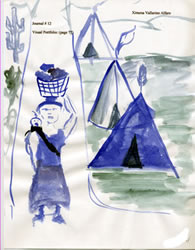To get nontraditional students to buy into journal writing takes time and
energy and the “creative” approach outlined in this module leads to increased
participation. It engages student interest and allows for
both the imaginative student and those who may doubt their creativity to express
themselves without fear of being castigated for not expressing themselves “correctly.”
This approach emphasizes creativity and quantity and deemphasizes spelling
and grammar errors. The logic beneath this emphasis is simple: writing
proficiency is a matter of practice. The more a student
writes and wants to write, the better a writer he or she becomes.
Of course, this applies to all disciplines. Although the
emphasis of this module is the development of a creative journal assignment
that could be applied to any course across the curriculum, other benefits besides
written expression accrue. Students’ responses reveal
their imaginative engagement with texts and illustrate their general understanding
of assignments, specific readings, and class discussions. Finally,
they show students’ grasp of the discipline in a way standardized tests do
not.
The importance of clear, clean communication cannot be over emphasized. As
the bedrock of academic discourse and industrial management, clear expression
allows us to understand each other. Without clear understanding,
ideas cannot be properly heard, discussed, accepted, or implemented. Beyond
fostering clear, clean writing, due to its breadth and depth, this assignment
also develops a number of other essential skills, including the ability to:
- Ask questions
- Understand directions
- Follow Directions
- Analyze
- Respond imaginatively to choices
- Take chances
- Learn from mistakes
- Meet deadlines
- Meet requirements
- Instigate self-directed work
- Participate in group work
- Suggestions for Journal Responses by
Andrea J. Kaston - The list of her twenty creative journal assignments
- Resources - Bibliography, Websites,
and Alternative Lesson Plans
- Journal Web Site - Developed
by the module author that includes a sample assignment, table of contents
and student models of each of Kaston's twenty journal responses
- Making Journal Entries
- Making a Table of Contents

